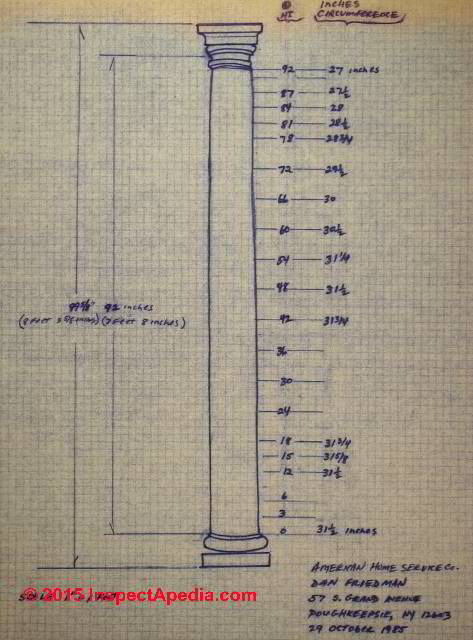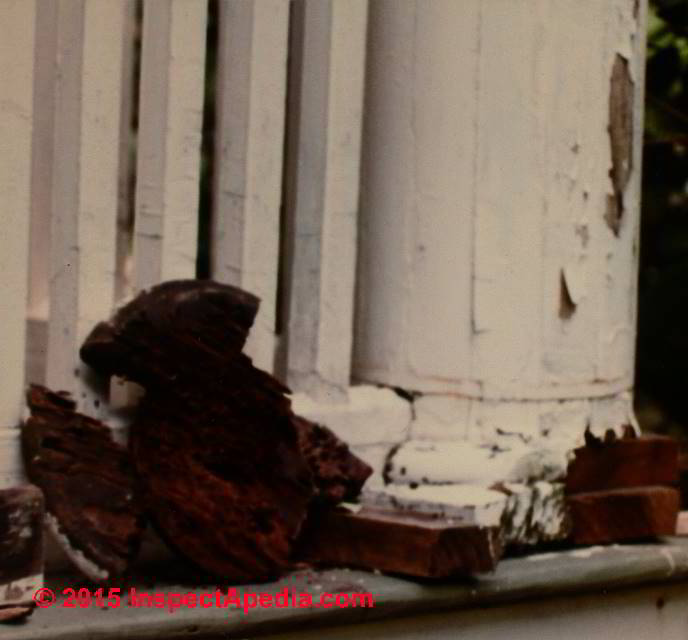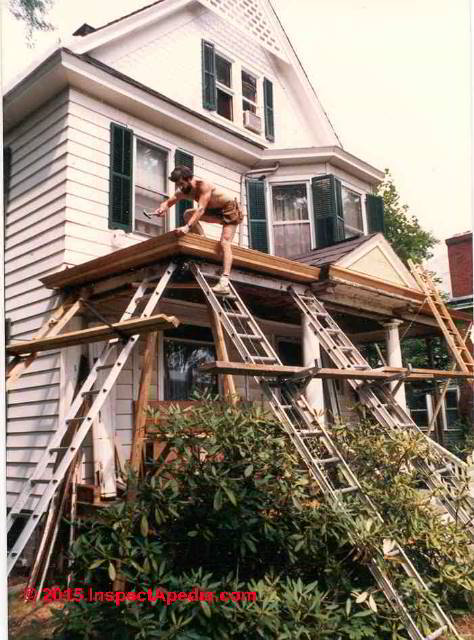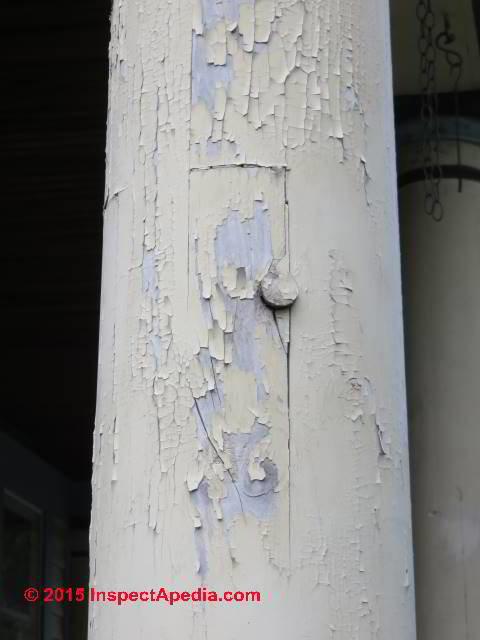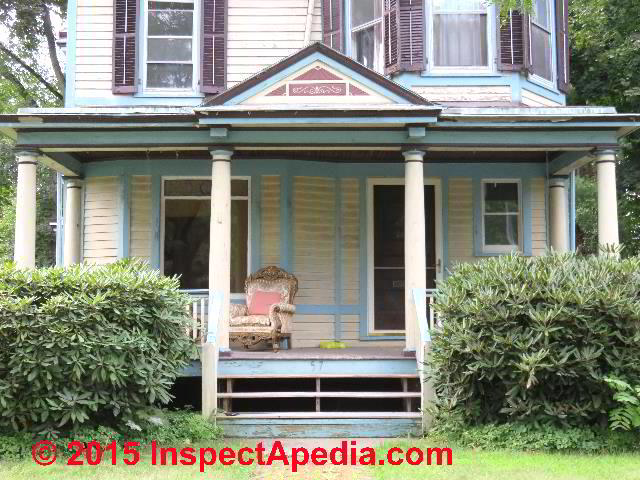 Round Wood Column Repair / Replacement for Porche
Round Wood Column Repair / Replacement for Porche
Porch Column Restore or Replace:
Assessment of a Porch Repair Durability Over 30 Years
- POST a QUESTION or COMMENT about the types of decorative & structural porch or interior decorative wood column failure in residential & light commercial buildings
Wood column installation, troubleshooting repairs: how to repair or replace a porch column.
This article describes the inspection, repair, or installation of both round and square wood columns often used on porches and sometimes used in building interiors.
Columns that split, lean, bend, sag or rot are often more than a cosmetic problem: often the column is also serving to support a porch roof or other building features. We describe the procedure for repairing porch columns and we examine the condition of the repaired and replaced porch columns at the time of original work and again at the same porch thirty years later in 2015.
InspectAPedia tolerates no conflicts of interest. We have no relationship with advertisers, products, or services discussed at this website.
- Daniel Friedman, Publisher/Editor/Author - See WHO ARE WE?
Wood Porch Columns: causes of damage, methods of repair or replacement

Causes of Damage to Round Wood Porch Columns
Wooden columns have been used on buildings for centuries; the Poughkeepsie home at 57 South Grand Avenue, shown at left and whose renovation we began in 1985 and whose renovation will be finished when all of the home's owners have died, included repairs to a porch whose roof, columns, floor, and floor structure had been rotted by decades of neglect and of course leaks.
That's Laura Waterman and Katie the Certified Environmental Inspector dog on the front porch of this home before repairs were begun in 1985. In 2015 the home stood empty and in need of repairs again.
Here we describe repairs to classical Doric style hollow lock stave wooden porch columns. We describe the original repair work and then we examine the durability of that work thirty years later.
This home, originally constructed in 1900, enjoyed a front porch across the width of the building. There from 1900 through the 1940's it was common for Poughkeepsie-ites to relax on the porch in the evening while an occasional car passed up or down Grand Avenue.
By the 1970's the home had been covered by aluminum siding, suspended ceilings had been installed inside, and as part of an extensive renovation, the front porch columns, rotted and split, needed repair or replacement.
Actually a little rot on a round hollow wood post is not the worst problem one encounters.
More serious damage to porch columns includes crushing column bases or plinth blocks, damage by rot, termites, or carpenter ants that, when combined with the sloping porch floor and perhaps with a sagging porch structure, places an un-even load on the column from front to back or side to side causing columns to split, lean, or even collapse. .
Choosing Replacement Porch Column Shapes & Profiles: Entasis is important
Because most round wood columns and certainly all of the larger sized columns were used on such homes are hollow they were built using techniques similar to barrel-making and in fact I call them hollow stave columns. Strips of wood with modest tongue and groove sides are glued together to form the column.
Then the column is given entasis - illustrated by my sketch below where I marked the column diameter measurements at various points up from its base to its top.
Entasis is a colulmn shape or profile formed by a convex curve designed to provide a pleasing form that was originally figured out by the Greeks and shown on classical columns. You'll see that entasis is tricky: it's not a symmetric curve.
Yet when viewed from a distance the columns look straight.
Entasis was used in the Egyptian pyramids but is most associated with the columns found in the Classical Period in Greece. In China entasis was discussed later, in 1103 by Yingzao Fashi. [Wikipedia atReferences or Citations ]
If you actually build a column without entasis, as were the ugly aluminum columns we considered as replacements, the column looks weird when in place - excessively tapered from bottom to top. Kudos to Greece.
Of three most column top or capital designs, Corinthian, Doric, or Ionic, the simplest and smoothest is the Doric column design, shown here. Smooth-surfaced Doric columns are the design most commonly found on wood porch columns.
Repair or Replacement Procedures for Rotted, Split, or Damaged Porch Columns
Anyhow, a hollow stave column, when exposed to uneven loads by the weight of the roof pressing down on a column that rests on a rotting or improperly shaped plinth block (base) wants to split. So column repairs will include both gluing back the split column staves and cutting/replacing rotted sections.
For a wood column that is smashed beyond repair, don't despair.
The split shown in the hollow wood column at above right can be repaired but I do not recommend just injecting epoxy into the open joints: you're making the column diameter ever wider and asking for more damage in the future.
A proper repair involves removing the column, opening the joints a bit further and blowing them clean and dry. Then glue is inserted and strap clamps are used to re-clamp the column to its original dimensions.
At above left you can see that damage to porch columns and often the porch floor usually begins at the porch roof or soffit and box beam that bears on the column tops. Leaky porch roof built-in gutters send water into the box beam and porch soffit where it rots those components as well as leaking into the columns below.
See EAVES TROUGH, INTEGRAL GUTTERS for details of how this porch and its eaves trough gutters were repaired.
What Happens When You Wrap a Home in Aluminum?
Above you can see at above left the water stains on the soffit and the box beam supporting the porch roof as well as at the top of our round stave wood porch column. Mrs. Perkins, the housekeeper for Mr. Perkins until his wife died, became Mrs. Perkins #2 and lived in this home for ensuing decades.
In the 1960's Mrs. Perkins #2 accepted a contractor's offer to cover the entire outside of the home in aluminum: aluminum siding and aluminum wrap covered all of the home's trim from top to bottom.
Wrapping a home in "no maintenance" aluminum was appealing to Mrs. Perkins who was facing a costly home paint job, but if the trim and siding are not properly installed to keep water out of the surfaces they cover (or to let it out if it enters), the result spells trouble for later owners such as Laura and Katie (the dog).
For example, at the home's front porch the aluminum wrapped around the box beam supporting the front porch acted as a gutter to trap leaks from above around the beam causing both beam rot and porch column rot.
Take a look at the column top (above right) and notice those dark vertical lines: the column staves were coming un-glued. In wider column segments and especially near the column base where water accumulated inside the hollow column these staves separate completely.
At above right you can see the deterioration of the roof cornice trim, soffit and box beam exposed after we finished removing the aluminum wrapper.
Above and below are photographs of the rotted and carpenter-ant damaged wood column base.
At above right you can see my temporary support jammed under the porch column but more important notice that the column is badly split. Someone had attempted to "repair" the porch column by attaching a metal band around its base.
Water running in the column interior soaked the column base and plinth block, rotted those components, and rotted the porch floor and supporting beam below. The corners of the porch floor structure were supported by hollow brick columns.
Water running inside those columns were an engraved invitation to carpenter ants who had moved into the columns too, adding to the excitement.
The brick columns (piers if you prefer) supporting the porch were falling apart and needed to be re-built from footings up (above left, 1985). I re-used the original bricks but modern mortar.
At the column top, not wanting the carpenter ants to have an easy access into the porch structure again, I installed a solid, custom-fabricated copper column top shown in the photo above. You'll also note that the porch floor repair lumber used treated wood. This was later covered with a fascia trim board for better cosmetic appearance.
At above is one of the same rebuilt brick supporting piers in 2015, three decades later: still intact thanks to that copper cap flashing just visible under the blue trim boards around the porch floor frame.
Watch out: there is no safe way to remove badly damaged porch columns like these without first constructing very secure independent supports for the porch roof - unless you're going to tear off the whole roof structure first. In this case the porch roof structure was salvageable: we just needed to rebuild the eaves trough gutters, soffits, and box beam below.
So we supported the roof to permit removal of the damaged porch columns at the left and right porch corners.
Above you can see how we supported this end of the porch roof so that the corner column could be removed for repair or replacement. At this point we've also begun repairs of the porch roof gutters and trim. We simply used a telepost (aka "jackpost" that is a telescoping column with a large screw in one end) to jack the roof just enough to permt removal of the old column.
Watch out: Bracing and cross-bracing are critial for safety when jacking a porch or removing columns.
Venting Suggestions for Hollow Lock Stave Wood Columns
While repairing the salvageable and replacing the worst wood columns on a Poughkeepsie New York home built in 1900 it made sense to pay special attention to flashing at post tops to prevent water entry from above, venting the hollow column interior to reduce rot and carpenter ant attacks, and to provide a sound and properly set column base or plinth block, adapted to the slope of the porch.
To vent the column I built a custom plinth block of solid treated lumber and cut arches at the sides of the block parallel to the wood grain so as to avoid splitting.
I set the columns with base vent openings to the left and right sides of the column so that they'd not be obvious from the street, and I bore my column top vent hole near the column top but on the porch interior side, again for cosmetic reasons. My original sketch below shows where these vent openings were placed.
At above in my original sketch and below photographed in 2015, 30 years after this renovation, you can see the vent opening at the top of the round hollow wood column.
Back in 1985, after I got sick of repairing the porch roof and gutters (below) it was time to either fix or replace the porch columns whose absence was disturbing everyone else.
We removed the scary angled temporary supports and installed temporary wood posts near the porch corners but leaving enough room to install the replacement round wood columns when they arrived.
Above we see that the same home in 2015 needs repairs and maintenance but I was pleased to see that my copper-lined eaves trough gutters had protected the box beam and soffits from water damage for three decades.
Above are images of the replacement corner posts that we brought up from the American Wood Column Corporation in Brooklyn, N.Y. in 1985. We matched our original columns that themselves may have come from this company or its predecessor, depending on when the original porch was constructed. American Wood Column Corp. has been in business since 1918.
At above right you'll see the deterioration that can appear after 30 years of weather exposure with no maintenance. No one painted these posts after our original installation and paint job back in 1985. This lock-stave hollow wood column is repairable: water has not been running in its interior and I saw no rot on the column whatsoever.
The center columns at this porch were in better shape and could be re-glued, repaired, and re-used.
The corner columns, on inspection, were, well, depressing. We drove down to Grand Street in Brooklyn, New York to buy almost perfectly-matching replacements for two of our Doric columns that were beyond repair.
The manufacturer glues up the wood stave column and then puts it on a gigantic lathe to cut the column to a profile with perfect entasis.
The repaired porch received the new columns at its corners. At above right is the same home photographed in August, 2015.
The property is for sale and needs at least a roof and exterior painting, but its Doric columned front porch is still standing. In the ensuing 30 years not one soul has seemed to notice that they are not an exact match for their center- sisters.
Above left: in 2015 it's time to replace those plinth blocks and some of the column bases, and other column repairs are past due.
I'd recommend using a pre-formed fiberglass column plinth block to put an end to rot worries and to improve the intake venting at each column base.
Above is the front porch at 57 S. Grand Avenue in Poughkeepsie in August 2015.
Replacement Lock Stave Wood Column Sources & Porch Repair Guides
- American Wood Column Corp., 913 Grand St., Brooklyn, NY 11211, Tel: 718-782-3163 Email: tpl913@verizon.net, Website: http://americanwoodcolumncorp.com/ - this company was the source of the replacement lock stave wood columns described in the article above.
- Architectural Mall, Tel: 877-279-9993, Website: http://www.columnsandbalustrades.com/, provides porch columns made of fiberglass, polymer stone, fiber reinforced polymer, PVC wrapped columns, Wood-stain grade columns (interior use), aluminum (extruded, uniform diameter), and polyuethane columns.
From the website this company's physical address appears to be a secret. - Pacific Columns, Inc., 505 W. Lambert Rd Brea, CA 92821, Tel: 800-294-1098, Architectural columns. Annoying talking website.
- Turntech, LLC, 114 Cocalico Creek Rd, Ephrata, PA 17522, Tel: 717.859.5944, Email: info@customturnings.com, Website: http://customturnings.com/ Custom Wood Columns and other products
- Better Homes and Gardens (Eds.), "The Porch Book [at Amazon.com] (Better Homes and Gardens) (Better Homes and Gardens Home)", Better Homes and Gardens (2011), ISBN-10: 0470948523,
ISBN-13: 978-0470948521
Features before-and-after photos that inspire you to give your home's exterior a facelift, Covers amenities that make porches more attractive, like lighting and fans, kitchen areas, decorative ceiling and wall treatments, flooring options, and much more, Offers design construction topics, like using an architect, permit issues, adding entryways, and more - Fine Homebuilding (Eds.), "Building Porches and Decks (For Pros by Pros)", [at Amazon.com] Taunton Press (2003),
The For Pros By Pros titles are compilations of articles from Fine Homebuilding magazine, selected by the editors of the magazine and organized by subject. New articles from recent issues of the magazine have been added to this edition of Building Porches and Decks.
Updated and redesigned throughout, this book gives builders the very best and current information. - German, Roger, "Porches and Sunrooms: Planning and Remodeling", [at Amazon.com]
- Hor, "Decks, Porches, and Patios (Home Repair and Improvement, Updated Series), [at Amazon.com]
- NPS, INAPPROPRIATE PORCH ALTERATIONS [PDF] ITS #9, U.S. National Park Service, Technical Preservation Services, "Interpreting
The Secretary of the Interior’s Standards for Rehabilitation", - retrieved 2022/10/02, original source: https://www.nps.gov/tps/standards/applying-rehabilitation/its-bulletins/ITS09-Porch-Alterations.pdf
Excerpt: : A porch with its balustrade serves as both a decorative and practical feature that can be very important in defining the character of a historic building. However, it is sometimes necessary to alter or replace balustrades during rehabilitation. - Schmidt, Phil, "Black & Decker: The Complete Guide to Porches & Patio Rooms", [at Amazon.com]
...
Continue reading at COLUMNS & POSTS, DEFECTS for problems with structural wood columns, or select a topic from the closely-related articles below, or see the complete ARTICLE INDEX.
Or see these
Recommended Articles
- AGE of a BUILDING, HOW to DETERMINE - home
- ARCHITECTURE, STYLE, & BUILDING AGE
- DECK & PORCH CONSTRUCTION - home
- PORCH CONSTRUCTION & SCREENING
Suggested citation for this web page
PORCH COLUMN REPAIR or REPLACEMENT at InspectApedia.com - online encyclopedia of building & environmental inspection, testing, diagnosis, repair, & problem prevention advice.
Or see this
INDEX to RELATED ARTICLES: ARTICLE INDEX to BUILDING DECKS & PORCHES
Or use the SEARCH BOX found below to Ask a Question or Search InspectApedia
Or see
INDEX to RELATED ARTICLES: ARTICLE INDEX to BUILDING STRUCTURES
Or use the SEARCH BOX found below to Ask a Question or Search InspectApedia
Ask a Question or Search InspectApedia
Try the search box just below, or if you prefer, post a question or comment in the Comments box below and we will respond promptly.
Search the InspectApedia website
Note: appearance of your Comment below may be delayed: if your comment contains an image, photograph, web link, or text that looks to the software as if it might be a web link, your posting will appear after it has been approved by a moderator. Apologies for the delay.
Only one image can be added per comment but you can post as many comments, and therefore images, as you like.
You will not receive a notification when a response to your question has been posted.
Please bookmark this page to make it easy for you to check back for our response.
IF above you see "Comment Form is loading comments..." then COMMENT BOX - countable.ca / bawkbox.com IS NOT WORKING.
In any case you are welcome to send an email directly to us at InspectApedia.com at editor@inspectApedia.com
We'll reply to you directly. Please help us help you by noting, in your email, the URL of the InspectApedia page where you wanted to comment.
Citations & References
In addition to any citations in the article above, a full list is available on request.
- American Wood Column Corp., 913 Grand St., Brooklyn, NY 11211, Tel: 718-782-3163 Email: tpl913@verizon.net, Website: http://americanwoodcolumncorp.com/
- Historic Preservation Technology: A Primer, Robert A. Young, Wiley (March 21, 2008) ISBN-10: 0471788368 ISBN-13: 978-0471788362
- Best Practices Guide to Residential Construction, by Steven Bliss. John Wiley & Sons, 2006. ISBN-10: 0471648361, ISBN-13: 978-0471648369, Hardcover: 320 pages, available from Amazon.com and also Wiley.com. See our book review of this publication.
- Decks and Porches, the JLC Guide to, Best Practices for Outdoor Spaces, Steve Bliss (Editor), The Journal of Light Construction, Williston VT, 2010 ISBN 10: 1-928580-42-4, ISBN 13: 978-1-928580-42-3, available from Amazon.com
- The Journal of Light Construction has generously given reprint permission to InspectAPedia.com for certain articles found at this website. All rights and contents to those materials are ©Journal of Light Construction and may not be reproduced in any form.
- Building Pathology, Deterioration, Diagnostics, and Intervention, Samuel Y. Harris, P.E., AIA, Esq., ISBN 0-471-33172-4, John Wiley & Sons, 2001 [General building science-DF] ISBN-10: 0471331724 ISBN-13: 978-0471331728
- Building Pathology: Principles and Practice, David Watt, Wiley-Blackwell; 2 edition (March 7, 2008) ISBN-10: 1405161035 ISBN-13: 978-1405161039
- Diagnosing & Repairing House Structure Problems, Edgar O. Seaquist, McGraw Hill, 1980 ISBN 0-07-056013-7 (obsolete, incomplete, missing most diagnosis steps, but very good reading; out of print but used copies are available at Amazon.com, and reprints are available from some inspection tool suppliers). Ed Seaquist was among the first speakers invited to a series of educational conferences organized by D Friedman for ASHI, the American Society of Home Inspectors, where the topic of inspecting the in-service condition of building structures was first addressed.
- Design of Wood Structures - ASD, Donald E. Breyer, Kenneth Fridley, Kelly Cobeen, David Pollock, McGraw Hill, 2003, ISBN-10: 0071379320, ISBN-13: 978-0071379328
This book is an update of a long-established text dating from at least 1988 (DJF); Quoting:
This book is gives a good grasp of seismic design for wood structures. Many of the examples especially near the end are good practice for the California PE Special Seismic Exam design questions. It gives a good grasp of how seismic forces move through a building and how to calculate those forces at various locations. THE CLASSIC TEXT ON WOOD DESIGN UPDATED TO INCLUDE THE LATEST CODES AND DATA. Reflects the most recent provisions of the 2003 International Building Code and 2001 National Design Specification for Wood Construction. Continuing the sterling standard set by earlier editions, this indispensable reference clearly explains the best wood design techniques for the safe handling of gravity and lateral loads. Carefully revised and updated to include the new 2003 International Building Code, ASCE 7-02 Minimum Design Loads for Buildings and Other Structures, the 2001 National Design Specification for Wood Construction, and the most recent Allowable Stress Design. - Building Failures, Diagnosis & Avoidance, 2d Ed., W.H. Ransom, E.& F. Spon, New York, 1987 ISBN 0-419-14270-3
- Domestic Building Surveys, Andrew R. Williams, Kindle book, Amazon.com
- Defects and Deterioration in Buildings: A Practical Guide to the Science and Technology of Material Failure, Barry Richardson, Spon Press; 2d Ed (2001), ISBN-10: 041925210X, ISBN-13: 978-0419252108. Quoting:
A professional reference designed to assist surveyors, engineers, architects and contractors in diagnosing existing problems and avoiding them in new buildings. Fully revised and updated, this edition, in new clearer format, covers developments in building defects, and problems such as sick building syndrome. Well liked for its mixture of theory and practice the new edition will complement Hinks and Cook's student textbook on defects at the practitioner level. - In addition to citations & references found in this article, see the research citations given at the end of the related articles found at our suggested
CONTINUE READING or RECOMMENDED ARTICLES.
- Carson, Dunlop & Associates Ltd., 120 Carlton Street Suite 407, Toronto ON M5A 4K2. Tel: (416) 964-9415 1-800-268-7070 Email: info@carsondunlop.com. Alan Carson is a past president of ASHI, the American Society of Home Inspectors.
Thanks to Alan Carson and Bob Dunlop, for permission for InspectAPedia to use text excerpts from The HOME REFERENCE BOOK - the Encyclopedia of Homes and to use illustrations from The ILLUSTRATED HOME .
Carson Dunlop Associates provides extensive home inspection education and report writing material. In gratitude we provide links to tsome Carson Dunlop Associates products and services.


